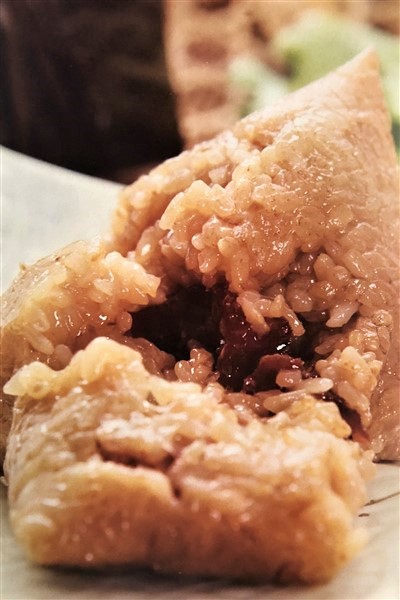Zhaoqing Zongzi
A Sticky and Savory New Year Tradition
Zhaoqing zongzi are zongzi (or sticky rice dumplings) that come from the city of Zhaoqing, in China. It is a sweet snack that is a must-have dish for families celebrating Chinese New Year in this city.
Zhaoqing residents are extremely particular about how they make their zongzi. The bamboo wrapping leaves, glutinous rice, and mung beans must all be fresh, and must all have been produced in the current year. The pork filling must have the right amount of lean and fatty content. The seasoning must contain five-spice powder and grain liqueur to make the filling aromatic. It should taste fatty, but not overly oily. Prepared zongzi are slowly roasted for ten or more hours over a large flame in order to fully mix the glutinous rice, mung bean, and pork flavors together.

Ingredients
- 2 ⅔ cups (500 grams) glutinous rice
- 7.05 ounces (200 grams) fatty pork
- 10.58 ounces (300 grams) mung beans
- 2 salted egg yolks
- 1 bamboo leaf, lotus leaves can be used as a substitute
- several lengths of twine
Seasonings
- five-spice powder
- grain liqueur
- light soy sauce
- salt
- chicken bouillon
- sugar
- sesame oil
- cooking oil
Cooking Directions
Preparations
- Wash fatty pork. Cut into rectangular pieces approximately 3/4 inch long. Stir with five-spice powder, grain liqueur, salt, light soy sauce, sesame oil, sugar, and chicken bouillon to taste. Cover with plastic wrap and refrigerate for 1 day.
- Wash mung beans. Soak in water overnight. Remove bean shells by hand. Wash again in a pan. Strain water away. Stir with sesame oil and salt to taste.
- Wash glutinous rice. Cover glutinous rice with water. Soak for 2 hours, until they can be easily broken apart with your hands. Strain water.
- Cut salted egg yolks in half. Wash bamboo leaf and twine separately. Blanch bamboo leaf in boiling water, then quickly remove.
How to wrap Zhaoqing zongzi
- Brush a bit of cooking oil on one side of the bamboo leaf. Place in bowl. Lay a layer of glutinous rice in the center of the leaf. Then lay another layer of mung beans over this. Add a bit of fatty pork and 1/2 salted egg yolk. Then lay another layer of mung beans and another layer of glutinous rice. Press ingredients flat with a spoon.
- Tip: Lotus leaves can be used instead of bamboo leaves when making Zhaoqing zongzi.
- Wrap the fillings completely with the bamboo leaf. Form into shape of a pyramid or a long pillow. Bind with twine to improve the cooked zongzi's texture.
Put it all together
- Place prepared Zhaoqing zongzi in a large pot. Fill with water. Add a dash of salt. Boil until thoroughly cooked.
- Tip: Adding salt while boiling the zongzi will increase its ability to withstand the boiling, thus improving the taste.
Zhaoqing Zongzi VS Regular Zongzi
The tradition of making zongzi for Dragon Boat Festival is more than 1,000 years old. In Zhaoqing city in Guangdong, it is also customary to eat zongzi to pass the New Year, and this tradition has a long history of its own.
Zhaoqing zongzi distinguish themselves from regular zongzi in four ways:
- It is bigger, with more noticeable sharp edges. It is pyramid-shaped and weighs at least 1.1 pounds.
- It must use green, fragrant bamboo leaves which grow in Zhaoqing to prevent the zongzi from spoiling. They are big enough to accommodate the larger size of Zhaoqing zongzi.
- Fresh, de-shelled mung beans are a special ingredient in Zhaoqing zongzi. Mung beans and glutinous rice have a 1:1 or 1:2 ratio.
- Zhaoqing zongzi are cooked slowly over an open flame for around 12 hours to allow the flavors of the glutinous rice, mung beans, and pork to completely fuse together. This gives the zongzi a sticky, rich taste and detoxifying properties.